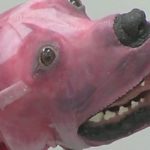 History
History  History
History  Technology
Technology Top 10 Everyday Tech Buzzwords That Hide a Darker Past
 Humans
Humans 10 Everyday Human Behaviors That Are Actually Survival Instincts
 Animals
Animals 10 Animals That Humiliated and Harmed Historical Leaders
 History
History 10 Most Influential Protests in Modern History
 Creepy
Creepy 10 More Representations of Death from Myth, Legend, and Folktale
 Technology
Technology 10 Scientific Breakthroughs of 2025 That’ll Change Everything
 Our World
Our World 10 Ways Icelandic Culture Makes Other Countries Look Boring
 Misconceptions
Misconceptions 10 Common Misconceptions About the Victorian Era
 Mysteries
Mysteries 10 Strange Unexplained Mysteries of 2025
 History
History 10 Things You Didn’t Know About the American National Anthem
 Technology
Technology Top 10 Everyday Tech Buzzwords That Hide a Darker Past
 Humans
Humans 10 Everyday Human Behaviors That Are Actually Survival Instincts
Who's Behind Listverse?

Jamie Frater
Head Editor
Jamie founded Listverse due to an insatiable desire to share fascinating, obscure, and bizarre facts. He has been a guest speaker on numerous national radio and television stations and is a five time published author.
More About Us Animals
Animals 10 Animals That Humiliated and Harmed Historical Leaders
 History
History 10 Most Influential Protests in Modern History
 Creepy
Creepy 10 More Representations of Death from Myth, Legend, and Folktale
 Technology
Technology 10 Scientific Breakthroughs of 2025 That’ll Change Everything
 Our World
Our World 10 Ways Icelandic Culture Makes Other Countries Look Boring
 Misconceptions
Misconceptions 10 Common Misconceptions About the Victorian Era
 Mysteries
Mysteries 10 Strange Unexplained Mysteries of 2025
10 Strange and Ancient Helmets
As long as there have been humans, there has been warfare and violence. Bashing each other over the head was one of the most basic ways of defeating your enemy. So one of the earliest bits of protective military equipment was a helmet designed to offer some defense against enemies trying to crack your skull. Over the millennia, many forms of helmets were developed, often with extraordinary decoration or made from unconventional materials.
Here are 10 of the oddest helmets from ancient history.
Related: 10 Biological And Chemical Weapons From The Ancient World
10 Conical Helmets
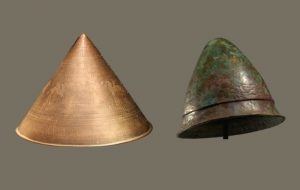
We tend to think of helmets as generally conforming to the shape of the skull they are supposed to protect. There are good reasons why that is true, but some unusual shapes were tried in early forms of helmets. One of these was the conical Kegelhelm and Pilos-type helmets.
The Kegelhelm was made of bronze from around the 8th century BC and was a very simple conic shape of folded metal. This cone sat on the top of the head and offered no protection to the face. Sometimes they had elaborate engravings on the surface, but the design’s flaws meant that this style did not last for long. When you hit a cone on the side, it tends to crumple… and so will the head of the person wearing it at the time.
The pileus was a common hat worn by laborers in ancient Greece and was formed from material in a high peak. This was the inspiration for the Pilos helmet, which kept the same shape but was made of bronze in the 5th century. It is thought that the shape was adopted to allow soldiers to also wear the pileus hat underneath the helmet for comfort. Some examples were highly decorated and have even been found with horns on top.[1]
9 Phrygian Helmet
The Phrygian cap is one of the most easily recognizable hats from the ancient world. It rises high above the head and curves forward into a little bent point. They came to be associated with liberty because they were given to Roman slaves when they were freed by their masters. They were employed in propaganda during the French and American Revolutions to show the revolutionaries were casting off the slavery of their despotic monarchs.
As we have seen, hats were sometimes the inspiration for helmets, and the Phrygian cap was no different. Examples of helmets made in the shape of Phrygian caps have been found in many places in the Greek world. This type of helmet was made famous by the cavalry of the Macedonians under King Philip and his son Alexander the Great. Many ancient representations of their armies show soldiers wearing Phrygian helmets.[2]
8 Crosby Garrett Helmet
The Phrygian style of helmet lasted for centuries and features in one of the most remarkable Roman discoveries ever made in Britain. A metal detectorist searching for artifacts near the village of Crosby Garrett in 2010 discovered a richly ornamented helmet topped with a statuette of a winged griffin—and the hauntingly realistic face attached to it.
Roman cavalry helmets, which completely covered the face of the wearer, have been discovered before, but the Crosby Garrett example is one of the most complete. It is thought that it was not designed for use in battle because when the face plate was in place, it would heavily restrict the user’s view. Instead, it was likely used in ceremonial situations. It would certainly create a stir.
Under English law, treasure can be purchased by the government at the market price to preserve important finds for the nation. Unfortunately, the law defines treasure as gold and silver. Because the Crosby Garrett helmet is made of copper alloy, it was not protected. It was sold at auction to a private buyer for £2,330,468.[3]
7 Golden Helmet of Coțofenești
Helmets tend to be made from some tough material to offer the most protection to their wearers. But helmets have also been used as symbols of royalty, power, and wealth when defense is not the primary concern.
In the 1920s, a Romanian child named Traian Simion was digging about in his village when he saw the glint of gold in the ground. Experts were called in, and it soon emerged that Simion had discovered a gold helmet made in the 4th century BC that belonged to one of the local Geto-Dacians tribes. The helmet would not have provided any protection for a warrior, but being made from more than 2 pounds (1 kilogram) of gold must have been most impressive when worn.
The find, known as the Helmet of Coțofenești, is covered with images that must have had important meanings for the people of the area. Across the front of the helmet are a pair of large and fierce eyes. This motif is known as an apotropaic symbol as it was thought to ward off evil and magic. Other images include a ritual sacrifice and mythical beasts.[4]
6 War Helmet of Meskalamdug
In 1924, British archaeologist Leonard Woolley excavated the royal burial grounds of the Mesopotamian city of Ur. One of the tombs dated from the 26th century BC and contained a bead bearing the name Meskalamdug known to be the King of Kush, meaning he ruled the cities of Sumer and Akkad. Alongside the skeleton of a man were numerous grave goods, including a war helmet made of pure gold.
The war helmet of Meskalamdug is shaped to look like the hair of its owner. Strands and waves of hair can be seen etched into the surface and beaten into complex shapes. As well as the hair, the ears are depicted. A golden band is seen woven around the skull.[5]
5 Helmet of Constantine
Helmets can be used for much more than simple protection. They can be potent political and social symbols of authority. They can also be used to proclaim a religious policy. The emperor Constantine did just that when he wore a helmet designed to trumpet his acceptance of Christianity in the 4th century AD.
Images of the emperor show him wearing a helmet marked with the Chi Rho symbol employed by the early Christians. But his helmet’s meaning went much deeper than the decoration. The emperor’s mother, Helena, made several visits to the Holy Land and brought back a number of relics. These included what was said to be the True Cross and the nails used in Jesus’ crucifixion. One of these nails was used in the construction of Constantine’s helmet. The writer Theoderet working at this time recorded that:
“The mother of the emperor… gave orders that a portion of the nails should be inserted into the royal helmet, in order that the head of her son might be preserved from the darts of his enemies.”[6]
4 Agris Helmet
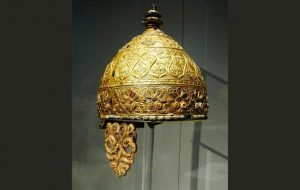
The Agris helmet is one of the masterpieces produced by the Celtic peoples of ancient France. Dating from around 350 BC, the helmet was recovered from a cave in 1981. The discovery of the helmet came just weeks after the cave itself had been discovered. When found, the helmet was not in a good state. It had broken into fragments and been scattered by a badger digging a hole.
The helmet itself was made from an iron cap plated with layers of bronze. These bands of bronze were cast into complex shapes and had further decoration beaten into the surface. Some of the decoration forms intricate interwoven leaves, vines, and branches. On the guard that hangs over the cheek, there is a horned serpent. A fine sheet of gold leaf was attached to them and worked into every recess of the helmet. As well as the glittering metalwork, small sections of coral were carefully shaped and attached.
Given the delicate gold and complex ornamentation, it seems unlikely that the helmet was ever worn in battle. Given the damage simply caused by burrowing animals, this is probably for the best.[7]
3 Waterloo Helmet
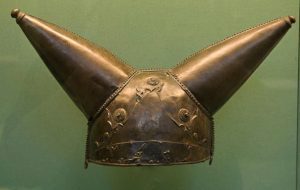
No horned helmets! The image of Viking raiders marauding from their ships with horned helmets on is often seen in children’s books but is not accurate. That is not to say that helmets with horns did not exist at times.
In 1868, the river Thames in London was being dredged near Waterloo Bridge. The Thames is packed with artifacts that have fallen into the river over the millennia. On this occasion, it was a helmet with two large conical horns dating from around 100 BC that was pulled to the surface. Beaten into the bronze that forms the main part of the helmet are symbols that have been found on other Celtic artifacts. Studs of red glass once decorated the surface and would have flashed blood-red in the sun.
Several images from the Iron Age show warriors wearing horned helmets, but the Waterloo helmet is the only example that has ever been discovered in Europe.[8]
2 Veksø Helmets
The Waterloo Helmet is not entirely unique in having horns. Two helmets with tall and curved horns dating from the earlier Bronze Age have been discovered in Denmark. Known as the Veksø helmets, after the place of their excavation, the helmets were dug up from a peat bog in 1942. The digger first noticed them when his spade crunched through something hard.
The two helmets that were recovered were almost identical to each other. Both are made from bronze and topped by high S-shaped horns. Each is decorated with raised bumps known as bosses. Two of the larger ones have curves above them which makes them look like a pair of eyes with eyebrows. A curved prominence may have been shaped to resemble the hooked beak of a bird of prey.
The helmets would not have been of much use in a battle. Having large horns that can be grabbed or will snag on weapons is not an advantage during a fight. They were probably used in rituals which may explain why they were found in a bog. Bronze Age people’s often left important objects in bodies of water as offerings to the gods.[9]
1 Boar’s Tusk Helmets
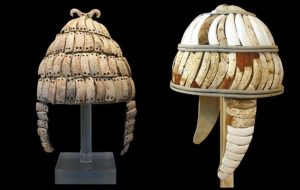
The Greek epic poems of Homer were first written down around the 8th century BC, but they describe a world that existed centuries earlier still. The Iliad and The Odyssey describe events around the Trojan War, which was already a mythical event to Greeks at the time. Many scholars doubted that there could be anything true in works composed so long after the events.
In The Iliad, there is a description of a curious helmet. “Meriones gave Odysseus a bow, a quiver and a sword, and put a cleverly made leather helmet on his head. On the inside, there was a strong lining on interwoven straps, onto which a felt cap had been sewn. The outside was cleverly adorned all around with rows of white tusks from a shiny-toothed boar, the tusks running in alternate directions in each row.”
Archaeology, however, has proved that such helmets really did exist in ancient Greece. Examples of helmets made from boar’s teeth constructed in exactly the way Homer described have been found dating from the 17th to the 10th century BC. Whether such helmets were worn for protection or as status symbols is unknown.[10]



